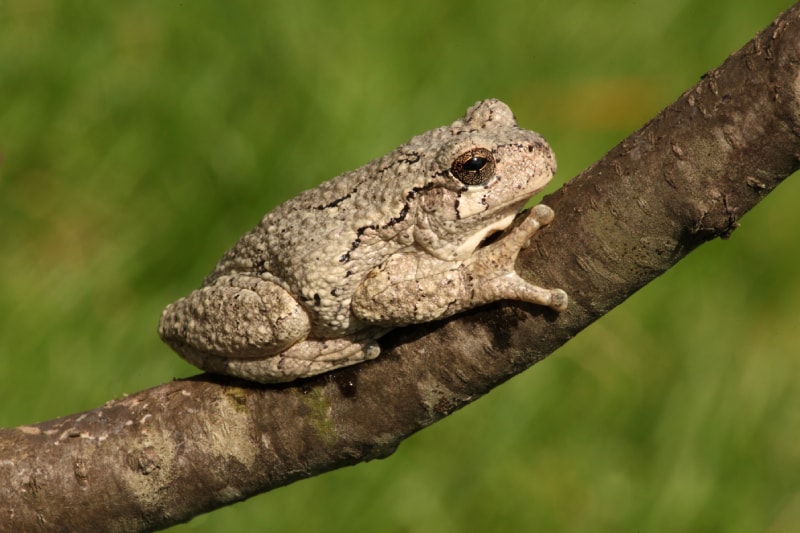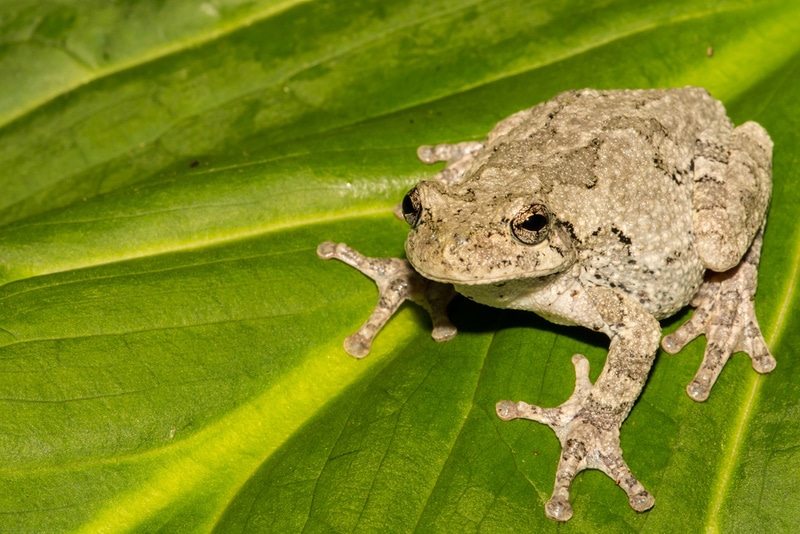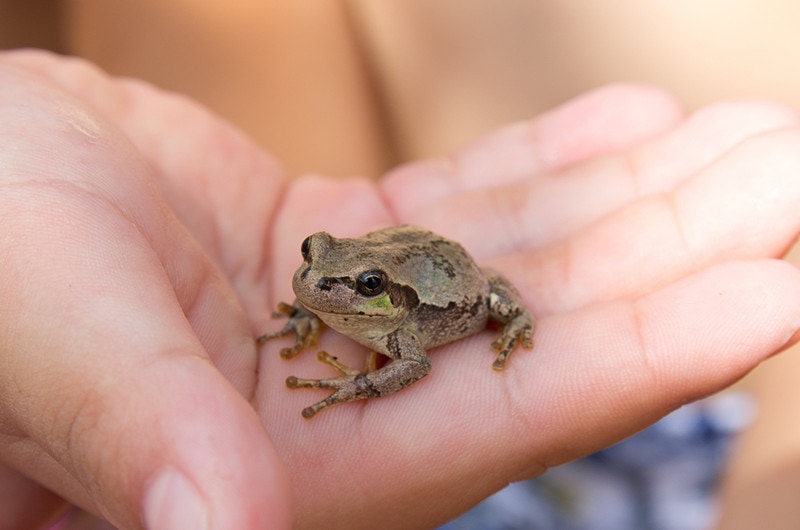Are Gray Tree Frogs Poisonous to Humans, Dogs or Cats? Vet-Approved Risks & FAQ

Updated on

Click to Skip Ahead
Despite all the toys we get for our pets, sometimes they play with something unsuitable, like a wild animal. If you’ve stumbled on your cat or dog near a Gray Tree Frog, you might wonder if it could be harmful to them or even poisonous.
When threatened, a Cope’s Gray Tree Frog will produce a noxious skin secretion that can irritate human skin. Unfortunately, for smaller animals like dogs or cats, it can potentially make them sick. However, there are no documented cases of pets becoming seriously ill. Below, we’ll discuss what could happen and what you should do if you suspect your dog or cat has been bothering a Cope’s Gray Tree Frog.
What Are Gray Tree Frogs?
There are two species for Gray Tree Frog that are almost indistinguishable by appearance, the Gray Tree Frog (Dryophytes versicolor) and the Cope’s Gray Tree Frog (Dryophytes chrysoscelis). They are large species of tree frog that can come in various colors, despite what their name suggests. They are commonly found in the eastern United States and southeastern Canada with the Cope’s Gray Tree Frog having a wider range in the Northern USA. They live in swamps, forests, and areas with small bodies of water like ponds.
Thanks to their particularly sticky feet, they spend most of their time in the trees, navigating through the branches. If required, they can change their color to match their environment from gray to brown or green. They are considered relatively easy to care for, and some people keep them as pets.

Are Gray Tree Frogs Poisonous?
The Gray Treefrog is listed as not poisonous but the Cope’s Gray Treefrog does produce a toxin that affects humans, dogs, and cats differently. We’ll discuss how the frog can affect each species to identify the risks.
1. Humans
Cope’s Gray Tree Frogs aren’t harmful to humans since the toxin they produce isn’t strong enough to cause serious harm. If you ingest it, it might cause mild discomfort. It won’t be absorbed into your skin but could make its way through your mouth, nose, or eyes. This could cause a burning sensation and a feeling of numbness.
If the toxin gets into your eyes, it could cause them to itch and burn—much like if you get chili pepper in your eye. It could even cause your eye to swell up. This means washing your hands is particularly important if you handle the frog with your bare hands.
There is an added risk if the person handling the tree frog is a child since they tend to stick their fingers in their mouths more often than adults.

2. Dogs and Cats
Even if your cat or dog is only playing, a Cope’s Gray Tree Frog isn’t going to take kindly to being bothered. Your pet will likely get a mouthful of bitter toxin, and they could also get it on their paws and later lick it off.
If your dog or cat ingests enough of the toxin, they might show signs of poisoning like drooling, foaming at the mouth, vomiting, and diarrhea. The risk increases if your dog or cat is older or isn’t in the best health. However, there have been no documented cases of pets being seriously injured after encountering a Cope’s Gray Tree Frog. Still, it’s best to take them to the veterinarian to be on the safe side and keep them away from all Gray Tree Frogs in the future if possible.

Toxins Aren’t All You Have to Worry About
Aside from secreting toxins, all Gray Tree Frogs, like many amphibians, sometimes carry salmonella bacteria. While that isn’t the case for all of them, you’ll never know which do or don’t carry the bacteria until it’s too late because it doesn’t make the frog ill.
If they carry salmonella, it will be in the digestive tract and then excreted in their waste, which your pet could ingest. Salmonella can result in cramps, fever, diarrhea, nausea, and vomiting in humans. While it is usually non-threatening, it can enter a human’s bloodstream, leading to a more serious illness. Thankfully, it can only harm humans if ingested, so as long as you wash your hands, you should be fine.
It’s rare for healthy dogs and cats to get salmonella, but it can still happen. And even if your pet isn’t showing signs, they can still spread the bacteria to their owners. In addition to that, frogs can carry parasites like tapeworms. Cats aren’t very likely to eat a frog, but dogs are serial offenders of eating things they shouldn’t. So, if your dog were to eat a gray colored tree frog, they are at risk of poisoning and developing a parasitic infection.

Could You Keep a Gray Tree Frog as a Pet if You Have Other Pets?
Yes, but you will have to keep them away from the other pets you have. Not only can they harm your cat or dog, but your other pets can also harm your frog. Barking can be stressful to a frog, even if they can’t physically get to the frogs.
If you want more than one frog, you can have multiple Gray Tree Frogs in the same terrarium if you get a suitable tank to house them all. And be aware that, like many amphibians, Gray Tree Frogs don’t like to be handled.
Some authorities do not recommend keeping them as pets as their natural environment is hard to recreate in a home.
Final Thoughts
Whether you’re keeping them as a pet or have noticed them in your yard, keeping your dog or cat away from them is best. Depending on the species they may have toxic secretions that can make your dog or cat sick and cause irritation if you ingest it, or it gets in through a cut on your finger. It’s essential to wash your hands thoroughly, and if you suspect your dog or cat has been bothering a Gray Tree Frog, take them to the veterinarian for a check-up.
Featured Image Credit: Steve Byland, Shutterstock











